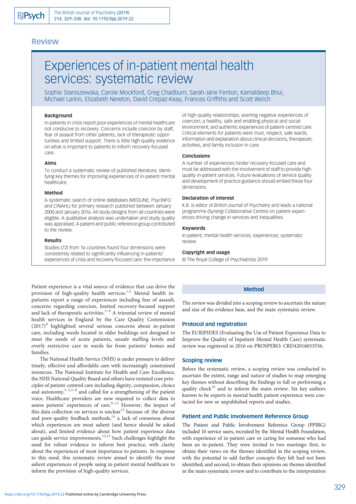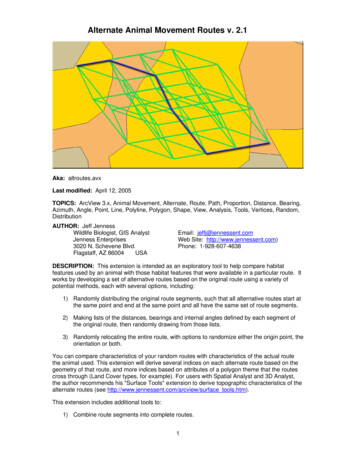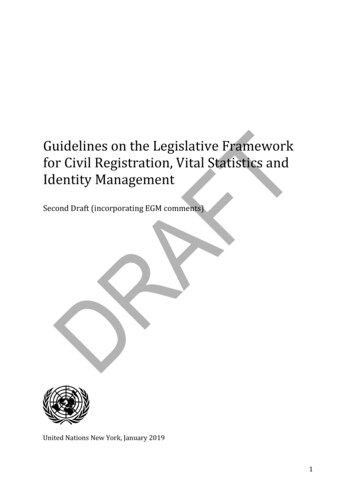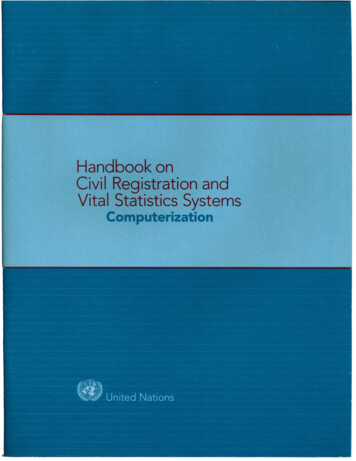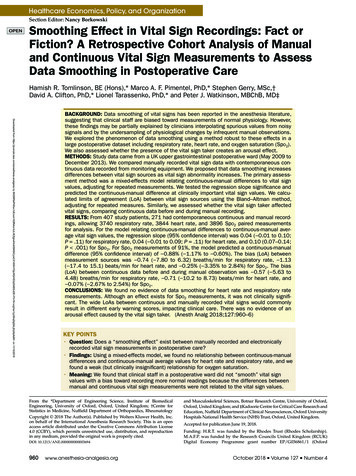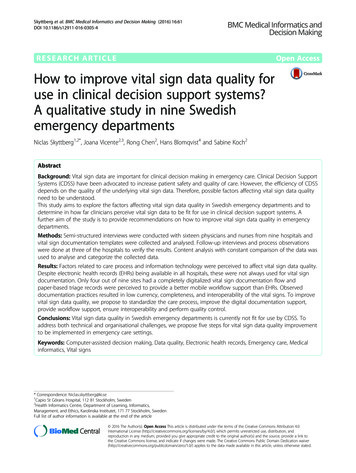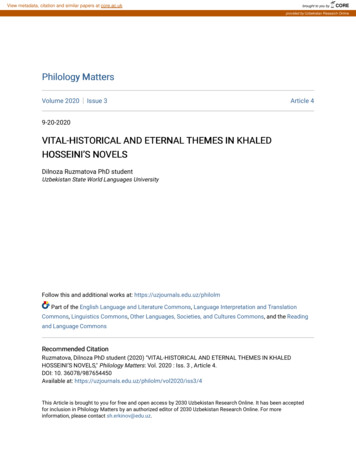
Transcription
View metadata, citation and similar papers at core.ac.ukbrought to you byCOREprovided by Uzbekistan Research OnlinePhilology MattersVolume 2020Issue 3Article 49-20-2020VITAL-HISTORICAL AND ETERNAL THEMES IN KHALEDHOSSEINI’S NOVELSDilnoza Ruzmatova PhD studentUzbekistan State World Languages UniversityFollow this and additional works at: https://uzjournals.edu.uz/philolmPart of the English Language and Literature Commons, Language Interpretation and TranslationCommons, Linguistics Commons, Other Languages, Societies, and Cultures Commons, and the Readingand Language CommonsRecommended CitationRuzmatova, Dilnoza PhD student (2020) "VITAL-HISTORICAL AND ETERNAL THEMES IN KHALEDHOSSEINI’S NOVELS," Philology Matters: Vol. 2020 : Iss. 3 , Article 4.DOI: 10. 36078/987654450Available at: is Article is brought to you for free and open access by 2030 Uzbekistan Research Online. It has been acceptedfor inclusion in Philology Matters by an authorized editor of 2030 Uzbekistan Research Online. For moreinformation, please contact sh.erkinov@edu.uz.
Ruzmatova: VITAL-HISTORICAL AND ETERNAL THEMES IN KHALED HOSSEINI’S NOVELSPhilology Matters / ISSN: 1994-4233ФМUzbek State World Languages University2020 Vol. 33 No. 3LITERATURECRITICAL STUDIESDOI: 10. 36078/987654450Dilnoza RuzmatovaДилноза РузматоваPhD student, Uzbekistan State World LanguagesUniversityЎзбекистон давлат жаҳон тиллари HISTORICAL AND ETERNALTHEMES IN KHALED HOSSEINI’SNOVELSХОЛИД ҲУСАЙНИЙ РОМАНЛАРИДАҲАЁТИЙ-ТАРИХИЙ ВА ИЯIn the study of literature the themes offiction are divided into vital-historical andeternal themes. Vital-historical themes refer tothe conditions resulted in character upbringingin the socio-historical situation and they can’texist outside of this certain time and place. Theeternal themes indicate the repeated events in allthe periods of all the nations. The combinationof several themes in one work is expressed inliterary studies with the concept of “thematic”.When faced with such a situation, one or twomajor themes may be separated, and the restshould be explored as secondary. The objective ofthis paper is to seek to remedy these problems byanalyzing the novels “The Kite Runner” and “AThousand Splendid Suns” by Afghan-Americanwriter Khaled Hosseini in terms of vital-historicaland eternal themes. The data collected from thedetailed analysis of the texts of Hosseini’s novelsmentioned above by applying biographic method.The research results in proving the fact that thewriter’s talent lies on fastening the theme ofAfghanistan equally in his all three books prein-post Taliban periods and in addition to thishe can indicate his own personal perspectivetowards the issues stated in the events. Hosseinicould fulfill his task in describing his desire andAfghan people in each part of the world for theblessed peace that the nation couldn’t witness fora long time. Moreover, the themes of childrenand childhood, women and womanhood orfamily traditions can be found regularly in allthe novels indicated above to strengthen the coremeaning of what is being Afghan and what isliving in Afghanistan. This study is an effort toАдабиётшунослик илмида бадиий асармавзуси реал ҳаётий-тарихий ёки мангу мавзуларга ажратилади. Ҳаётий-тарихий мавзулар у ёки бу макондаги ижтимоий-тарихийвазият сабабли пайдо бўлган шароит, ҳолатва характерни англатади ҳамда улар айни замон ва макондан ташқарида мавжуд бўлмайди.Мангу мавзулар эса барча халқларнинг барча давр ва босқичларида қайтариладиганвоқеаларни англатади. Бир асардаги бир нечамавзунинг йиғиндиси �а” тушунчаси билан ифодаланади.Бундай ҳолатга дуч келинганда, бир-иккиасосий мавзу ажратилиб, қолганлари иккинчи даражали кичик мавзу сифатида тадқиқэтилиши жоиз. Ушбу тадқиқотда мақоланингмақсади Холид Ҳусайний асарлари тематикасини “Шамол ортидан югуриб”, “Мингқуёш шуъласи” ва “Тоғлар ҳам садо беради”романлари мисолида таҳлил этишдир. УндаХолид Ҳусайний романлари биографик методасосида изчил таҳлил қилинган. Натижада,ёзувчи истеъдоди ҳар уч романда Афғонистонмавзусини Толибонлар ҳокимиятидан олдин,Толибонлар ва Толибонлардан кейинги даврларда тасвирлашида ҳамда романдаги ижтимоий воқеаларга ўзининг перспектив муносабатини билдиришида яққол сезилиши илмийасосланган. Афғон миллатига мансублик ваёки Афғонистонда яшаш нима эканлигинингмоҳиятини романлардаги болалар ва болалик, аёллар ва аёллик, оила анъаналари кабимавзулар орқали изоҳлаш мумкин. Хулосадаҳаётий-тарихий ва мангу мавзуларни таҳлилқилиш асносида Афғонистоннинг толибонлар,E-ISSN: 2181-1237Published by 2030 Uzbekistan Research Online, 2020891
Philology Matters, Vol. 2020 [2020], Iss. 3, Art. 4Series: Literature Critical Studiesunfold the significance of literary characteristicsof the novels those mentioned above. The studyconcludes that Khaled Hosseini applied the vitalhistorical and eternal themes in his three novelsto illustrate the objective picture of Afghanistanpre-in-post Taliban period.Key words: vital-historical themes, eternalthemes, Afghanistan, childhood, womanhood,family, war.2020 Vol. 33 No. 3улардан олдинги ва кейинги даврлардаги объектив манзарасини ёритилганлиги илмий-назарий жиҳатдан кўрсатиб берилган.Калит сўзлар: ҳаётий-тарихий мавзулар,мангу мавзулар, Афғонистон, болалик, аёллик,оила, уруш.INTRODUCTIONAfghan born American writer Khaled Hosseini’s works are highly beingstudied by contemporary scholars since the emergence of Afghan-American diasporaliterature. In terms of diaspora features Mir Hikmatullah Sadat [2006; 293] focusedon the importance of being Afghan in Afghanistan and outside the country concerningthe writer’s personages in the research “The Afghan Experience: An ExploratoryStudy of Societal Realities through the Lenses of Afghan Diasporic LiteraryWorks”. The next considerable work devoted to the essence of refugee literatureis “Intergenerational Trauma in Second Generation Afghan-American males” byAbid Wice Mohammad Niazi [2019;178] who divided Afghan-Americans into twogenerations: the first generation arrived in the country at the beginning of the 80s andtheir children represented the second generation who are fluent in English. WhilstAlicia Dorothea Angemeer [2012; 241] helped to establish an explanatory model forpopular books about Muslims in her argumentative research “Reading the Other andReading Ourselves: An Interpretative Study of amazon.com Reviews on Bestsellersabout Muslims”.The term Afghan-American is a post–9/11 creation. As an American ethniccommunity, Afghans did not come to speak of themselves as Afghan Americans untilpost – 9/11 required to this particular community to voice their opinions and offertheir assistance and expertise in the situation in Afghanistan [Huang G., 2009; 1197].This proves the fact that the notion Afghan-American is a rather new concept and theincomplete list of well-known writers of this trend are Khaled Hosseini, Mir TamimAnsary, Farooka Gauhari, Mariamam Qudrat Aseel, Nilofar Pazira and more others.No other writer has achieved the fame and acclaim of the California-based doctorKhaled Hosseini. All his three novels have been accepted warmly by world-widereaders. His first novel “The Kite Runner” [Hosseini Kh., 2002; 37] celebrates thesensational childhood friendship whereas his next novel “A Thousand Splendid Suns”[Hosseini Kh., 2007; 384] enters the world of Afghan women. What is more “And theMountains Echoed” [Hosseini Kh., 2013; 402] provides a valuable insight into theimaginary fictional world of the author in transferring his characters from one placeinto 0/iss3/4DOI: 10. 36078/9876544502
Ruzmatova: VITAL-HISTORICAL AND ETERNAL THEMES IN KHALED HOSSEINI’S NOVELS2020 Vol. 33 No. 3Series: Literature Critical StudiesMETHODOLOGYIn the present analysis, the research problem is to investigate how vital-historicaland eternal themes have been employed to represent Khaled Hosseini’s literary imageas a writer. The data collected from the detailed analysis of the texts of Hosseini’snovels “The Kite Runner” and “A Thousand Splendid Suns” helped answer thequestions related to the major and secondary themes in Hosseni’s fictions.THE PROCEDURE OF THE RESEARCHAccording to the investigated vital-historical and eternal themes in KhaledHosseini’s novels the analysis of his works has been undertaken at the followinglevels:1) Themes in “The Kite Runner”2) Themes in “A Thousand Splendid Suns”DISCUSSIONThe objective of the present analysis was to identify the themes in KhaledHosseini’s novels by separating vital-historical and eternal themes including thecharacteristics of Afghan-American diaspora literature.THEMES IN “THE KITE RUNNER”The main theme of “The Kite Runner” is “children and childhood” and the bookhas a number of secondary themes. The author addresses the eternal themes such as“guilt, friendship, childhood, love” and in a parallel way with a vital-historical themeof “the consequences of Afghanistan and its destabilization”.The theme of guilt appears in the images of Amir and Baba from the first pagesof the work. Amir felt guilty for several reasons: he felt guilty for his mother who died prematurely at the time of his birth; he was not been physically as strong as his father expected; and most of all, he accused Hassan foran unfair theft.Amir’s brutality and cruelty towards Hassan caused him to slander him. Notonly Amir, but his father Baba is another sufferer due to his mistakes. His biggest faultwas his unfaithfulness to his wife, betraying her, having an affair with his servant’swife. What is more tragic – he had an illegitimate son with her and he had to endurebeing a witness of the humiliation of his son as Hazara by other high ranked Pashtunchildren. But the success of the novel is that because of this sense of guilt, Amir andBaba try to be good people and correct their mistakes.The theme of friendship is echoed by the writer based on antithesis. The existenceof not only friendship, even positive relationship between Pashtun and Hazara was arevolution of that historical period. The personages of the novel, the Pashtuns Babaand Amir, are deeply connected to the lower class Hazara Hassan and they alwaysfelt necessity to him. However, Amir was also unlikely to show his condolencestowards Hassan among others since the society has “nurtured” him as a “high-ranked”representative.Amir mentioned that they were kids who had learned to crawl together, and no91Published by 2030 Uzbekistan Research Online, 20203
Philology Matters, Vol. 2020 [2020], Iss. 3, Art. 4Series: Literature Critical Studies2020 Vol. 33 No. 3history, ethnicity, society, or religion was going to change that either. I spent most ofthe first twelve years of my life playing with Hassan. Sometimes, his entire childhoodseems like one long lazy summer day with Hassan, chasing each other between tanglesof trees in my father’s yard, playing hide-and-seek, cops and robbers, cowboys andIndians, insect torture – with their crowning achievement undeniably the time weplucked the stinger off a bee and tied a string around the poor thing to yank it backevery time it took flight [Hosseini Kh., 2003; 25-26].This friendship chooses neitherage, social status, nor religious proportionality, so that the range of friendship in thework can be divided into three areas:1) Baba and Hassan – friendship between true religious people who hate religion;2) Amir and Hassan – eternal friendship between Pashtun and Hazara;3) Amir and Sukhrob – friendship between a man who understands the truth anda mature child.The theme of love is the invention of the writer; he prefers Soraya, who cannotbe accepted as a woman by Afghan nation, to be loved and respected unconditionallyby the main character Amir. At this point Hosseini was able to express his Americanthinking and influence of the region’s culture on the Afghan diaspora in America.Soraya escaped with her boyfriend and lived in a remote place, despite her parents’reaction, and decided to live independently as an American girl before meeting Amir.However, the young man was addicted to drugs and kept torturing her thoroughly.Although his parents could not bear this shame, they forgave their daughter andforgave her. The work is regarded as a collection of portrayals of male characters,reveals the true love between Soraya and Amir, which ignores stereotypes, and showsits resilience to live peacefully without a child. Because of that eternal bond, theywere given Sukhrob as a son at the end of the novel.The theme of childhood is one of the most striking scarces proving the writer’sskills and the heroes’ childhood stories make up the bulk of the plot. The author wantsto see the world, its peace and harmony in the eyes of children. While characterssuch as Amir, Hassan and Assef demonstrated the pre-war prosperity of childrenin Afghanistan, Sukhrob and other orphan kids summarized the image of Afghanchildren who were left as a result of war destitutes. Amir and Sukhrob’s dialogue –conversation between the grown up son protected by his father moved to America andan orphan boy tortured by the Taliban in Afghanistan could open all the truth belongedto Afghan children and unlucky destiny:– “Do you miss your parents?” he (Sohrab) asked, resting his cheek on hisknees, looking up at me.– “Do I miss my parents? Well, I never met my mother. My father died a fewyears ago, and, yes, I do miss him. Sometimes a lot.” (Amir)– “Do you remember what he looked like?” (Sohrab)I thought of Baba’s thick neck, his black eyes, his untruly brown hair. Sittingon his lap had been like sitting on a pair of tree trunks. – “I remember what he lookedlike”, I said. “What he smelled like too” (Amir).– “I’m starting to forget their faces,” Sohrab said. “Is that /iss3/4DOI: 10. 36078/9876544504
Ruzmatova: VITAL-HISTORICAL AND ETERNAL THEMES IN KHALED HOSSEINI’S NOVELS2020 Vol. 33 No. 3Series: Literature Critical StudiesAmir concerned “I thought of a line I’d read somewhere, or maybe I’d heardsomeone say it: There are a lot of children in Afghanistan but little childhood”[Hosseini Kh., 2003; 317-318].Afghanistan is a complicated theme including a wide range of themes inside.It is Hosseini’s confession about his country and his nation to the world- wide. Thetheme of Afghanistan is based on a series of dualities such as war and peace, sinand forgiveness, finding and losing, understanding and being understood. The saddepiction of Afghans moving from pre-war prosperity to post-war ignorance wasdepicted masterfully. Female studying and teaching at an educational establishment isrevealed in the character of Amir’s mother Sofia Akrami who worked as a teacher ofPersian literature and language at Girls High School. Bringing children to school inFord-Mustang, Opel cars, and over-the-top European banquets are also extravagant.Amir’s memories are illustrated focusing on Afghanistan contrast between pre- andpost-war: (Amir’s thirteenth birthday was planned and organized in a luxury way)“Iguess in most ways, or at least in the ways in which parties are judged, my birthdaybash was a huge success. I’d never seen the house so packed. Guests with drinks inhand were chatting in the hallways, smoking on the stairs, leaning against doorways.They sat where they found space, on kitchen counters, in the foyer, even under thestairwell. In the backyard, they mingled under the glow of blue, red, and green lightswinking in the trees, their faces illuminated by the light of kerosene torches proppedeverywhere. Baba had had a stage built on the balcony that overlooked the gardenand planted speakers throughout the yard. Ahmad Zahir was playing an accordionand singing on the stage over masses of dancing bodies” [Hosseini Kh., 2003; 94-95].When Amir came from America to Afghanistan in search of Sukhrob, he said:Everywhere I looked, that was what I saw. I remembered beggars in the old days too– Baba always carried an extra handful of Afghani bills in his pocket just for them;I’d never seen him deny a peddler. Now, though, they squatted at every street corner,dressed in shredded burlap rags, mud-caked hands held out for a coin. And the beggarswere mostly children now, thin and grim-faced, some no older than five or six. Theysat in the laps of their burqa-clad mothers alongside gutters at busy street corners andchanted “Bakhshesh, bakhshesh!” And something else, something I hadn’t noticedright away: Hardly any of them sat with an adult male – the wars had made fathers arare commodity in Afghanistan [Hosseini Kh., 2003; 256].Though being Hosseini’s debut novel, “The Kite Runner” won the recognitionof readers and literary writers from around the world. The subject matter of the writeris one of the main factors that demonstrates the artistic originality of the work.1.1. Themes in “A Thousand Splendid Suns”Hosseini's second novel “A Thousand Splendid Suns” focuses on “womenand womanhood” as a major theme with a number of secondary themes. Hosseiniemphasizes such real-historical themes, as stated in “The Kite Runner”,“war causesand effects in Afghanistan” in “A Thousand Splendid Suns” in parallel with eternalthemes as “women, love, marriage, sacrifice, returning to homeland”.The author’s goal of choosing women and womanhood as a central theme is to93Published by 2030 Uzbekistan Research Online, 20205
Philology Matters, Vol. 2020 [2020], Iss. 3, Art. 4Series: Literature Critical Studies2020 Vol. 33 No. 3express the fate of Afghan women in pre-and-post-war situations both in their familyand the society. The writer’s skill in portraying the women of all age levels inferiorto men could indicate traditional Afghan families. Mariam and Laila’s life lines arecharacterized by childhood, matrimony, love and friendship as features prove thequalities of the genre “bildungsroman”.Firstly, it is better to focus on Mariam’s time line which possesses a few itemsas being acknowledged as “harami” at the age of five, forcing to the marriage whenshe is only fifteen, after four years later of her marriage the third wife (Laila) of herhusband was born, living together for twenty seven years couldn’t be the reason to killher husband for the sake of protecting Laila and her children.Secondly, being totally different from Mariam’s fate, Laila’s birth was a bigcelebration for the family, moreover, she is the only personage who has ever felt theaffection of kindness and love in the novel. She attended school, obtained modernknowledge, loved and being loved by Tariq. While life awarded her with happiness,suddenly a fourteen-year-old girl who was separated from her family by accident wasmarried to Rasheed, who was then over sixty. Once even she decided to commit suicidebut realizing that she was pregnant from Tariq she could find strength to continue herlife. At the age of fifteen, she achieved maternal happiness, gave a birth to Aziza –Tariq’s daughter and four years Laila and Rasheed’s son Zalmay was born. At the ageof twenty-three, she reunited with Tariq – her first and foremost love. Laila, Tariqand children left Afghanistan to Pakistan with the help of Mariam where they couldfeel happy and peaceful environment for two years and yet in 2003 Laila persuadedTariq to return to their motherland. As Laila’s father told her she wanted to give allher possible support for developing Afghanistan. She did believe the coming light toAfghanistan and her existence there would be beneficial to someone.While shifting to Laila’s daughter, the youngest female character of the novelAziza, one can witness that at the beginning of the novel her birth could bring countlessjoy only to her mother for the reason that she did give a birth to her first love Tariq’sdaughter, and later Aziza’s existence gave Mariam an endless happiness. The writer'sskill is to find both heroines Aziza and Mariam born out of wedlock and tie theirmutual understanding with invisible layers as neither Mariam no Aziza knew abouteach other’s unfortunate destiny – parental mistakes.The most striking female character of the novel is Nana – Mariam’s mother whois the unhappiest person the writer created through his career. Hosseini didn't evendescribe the character’s laughing or even smiling and her positive attitude towardslife. To some extent, the only happiness she could find is her daughter Mariam andfor Nana it was enough to live in a remote place with her. Life continued to showits tough side to Nana and her daughter Mariam left her to find her own father Jalilwho couldn’t accept her in front of his legitimate children and wives. For Nana therewasn’t any reason to live and she found the single solution that is committing suicide.Although Islam is the main religion in Afghanistan, it is too difficult to find realMuslim care and respect to women both in the society and in families as depicted inthe novel. It is a typical task for female characters to give a birth, be busy with ss3/4DOI: 10. 36078/9876544506
Ruzmatova: VITAL-HISTORICAL AND ETERNAL THEMES IN KHALED HOSSEINI’S NOVELS2020 Vol. 33 No. 3Series: Literature Critical Studieschores and obey their husbands without any resistance. Hosseini emphasized thatmany families were left homeless and without financial supporters because of the warin the country, and that for widows, who were strolling through the streets, “home andland became the biggest dream of every woman” even “were willing to donate bloodto find a mate”. The author's intention to include women of all ages is to show thesame unhappiness and helplessness regarding all females in the country; however, hebelieved in achieving positive attitude toward women in Afghanistan's future througha perspective approach.The next theme of the novel is love. Although it is initially reflected in theintimate bonds that arose from Tariq's and Laila’s childhood affection, the narrativeportrays this high feeling of humanity, such as loyalty, understanding and caring. Theywere walking up the street together when they'd passed Rasheed, the shoemaker, withhis burqa-clad wife, Mariam, in tow. As he'd passed by them, Rasheed had playfullysaid, "If it isn't Laili and Majnoon," referring to the star-crossed lovers of Nezami'spopular twelfth-century romantic poem – a Farsi version of Romeo and Juliet, Babisaid, though he added that Nezami had written his tale of ill-fated lovers four centuriesbefore Shakespeare [Hosseini Kh.,2013;169].These passionate feelings of childhood can turn into a serious relationship,and the turmoil of the country is inevitable. Tariq's love was so strong that he evenadopted Rasheed's son Zalmay as his own son. They arrived in Murree – Pakistanand got married on the first day. In the mirror, beneath the green veil that the mullahdraped over their heads, Laila's eyes met Tariq's. There were no tears, no wedding-daysmiles, and no whispered oaths of long-lasting love. In silence, Laila looked at theirreflection, at faces that had aged beyond their years, at the pouches and lines and sagsthat now marked their once-scrubbed, youthful faces. Tariq opened his mouth andbegan to say something, but, just as he did, someone pulled the veil, and Laila missedwhat it was that he was going to say. That night, they lay in bed as husband and wife,as the children snored below them on sleeping cots. Laila remembered the ease withwhich they would crowd the air between them with words, she and Tariq, when theywere younger, the haywire, brisk flow of their speech, always interrupting each other,tugging each other's collar to emphasize a point, the quickness to laugh, the eagernessto delight. So much had happened since those childhood days so much that needed tobe said. But that first night the enormity of it all stole the words from her. That night,it was, blessing enough to be beside him. It was blessing enough to know that he washere, to feel the warmth of him next to her, to lie with him, their heads touching, hisright hand laced in her left [Hosseini Kh., 2013; 367]. A few lines of this passagedemonstrate the ‘bildungsroman’ feature of the work and that is evident. Heroes grewto spiritual maturity and grew up on the heights of life.In addition to the love between Tariq and Laila, the writer also refers to the lovebetween Rasheed and his first wife who died while giving a birth in the short episodes.Rasheed did not disclose these feelings to anyone, but kept her photos away from theeyes. One day Mariam found two pictures in the bottom drawer of the dresser. Oneof them was Yunus – Rasheed’s son who got drowned in the lake. In another photo,95Published by 2030 Uzbekistan Research Online, 20207
Philology Matters, Vol. 2020 [2020], Iss. 3, Art. 4Series: Literature Critical Studies2020 Vol. 33 No. 3a seated woman and, behind her, a thinner, younger Rasheed, with black hair. Thewoman was beautiful. Not as beautiful as the women in the magazine, perhaps, butbeautiful. Certainly more beautiful than her, Mariam. She had a delicate chin andlong, black hair parted in the center. High cheekbones and a gentle forehead. Mariampictured her own face, her thin lips and long chin, and felt a flicker of jealousy. Shelooked at this photo for a long time. There was something vaguely unsettling aboutthe way Rasheed seemed to loom over the woman. His hands on her shoulders. Hissavoring, tight-lipped smile and her unsmiling, sullen face. The way her body tiltedforward subtly, as though she were trying to wriggle free of his hands. This shortparagraph illustrates the endless love that Rasheed had in his heart and that he hadonce lived in love and happiness [Hosseini Kh., 2013; 88].Hosseini explains marriage as a purely belief based on Muslim traditions whichare not familiar to Western readers. The artistic details used in the marriage of Mariamand Rasheed, as well as the responsibilities of the bride and groom are described indetail in the work. Mariam (bride)was given a long-sleeved, dark green dress to wearover white cotton trousers. Afsoon (one of Jalil’s wives) gave her a green hijab anda pair of matching sandals. She was taken to the room with the long, brown table,except now there was a bowl of sugar-coated almond candy in the middle of thetable, a Koran, a green veil, and a mirror. Two men Mariam had never seen beforewitnesses, she presumed-and a mullah she did not recognize were already seated at thetable. Jalil showed her to a chair. He was wearing a light brown suit and a red tie. Hishair was washed. When he pulled out the chair for her, he tried to smile encouragingly.Khadija and Afsoon sat on Mariam’s side of the table this time. The mullah motionedtoward the veil, and Nargis arranged it on Mariam's head before taking a seat. Mariamlooked down at her hands. “You can call him (Rasheed – bridegroom) in now, ”Jalilsaid to someone [Hosseini Kh., 2013; 55-56]. The order of marriage also providesan opportunity to approach the work on the principle of clarity. In this process Mullafirst gave a brief speech on the necessity of marriage and the couple's responsibilities.He first asked Jalil (the bride's father) for his consent to the marriage. Jalil nodded.Rasheed was then asked for consent. Rasheed answered yes.“And do you, Mariam-jan, accept this man as your husband?” Mariam stayedquiet. Throats were cleared. “She does”, a female voice said from down the table.“Actually”, the mullah said, “she herself has to answer. And she should wait until Iask three times. The point is, he's seeking her, not the other way around”. He askedthe question two more times. When Mariam didn't answer, he asked it once more, thistime more forcefully – Mariam could feel Jalil beside her shifting on his seat, couldsense feet crossing and uncrossing beneath the table. There was more throat clearing.A small, white hand reached out and flicked a bit of dust off the table. “Mariam”, Jalilwhispered. “Yes”, she said shakily [Hosseini Kh., 2013; 56-57].Finally they put a mirror on Mariam. Mariam looked back at her face: hereyebrows were uneven, her hair was weak and lifeless, and her dark blue eyes were soclose that she could be thought of as curly, her skin was too broad, her forehead wasthin, and her cheeks were . Yes, it was hard to find beauty badges, but at the s3/4DOI: 10. 36078/9876544508
Ruzmatova: VITAL-HISTORICAL AND ETERNAL THEMES IN KHALED HOSSEINI’S NOVELS2020 Vol. 33 No. 3Series: Literature Critical Studiestime, she was not ugly, but a pretty girl. For the first time, he looked at Rasheed witha squinting face, a cheeky and noble face, his nose edged, his two spiked teeth, hiseyebrows hanging like a patch, and his thick, dark hair white. Suddenly, their gazecollided in the mirror. After that, Rasheed pulled the wedding ring out of his pocketand placed it on the girl’s trembling finger, though the ring was narrower. A marriagecontract has been signed. Mariam wrote the name of the meem, the reh, theyaa, andagain the meem on the document's destination.Through the theme of marriage, the writer also emphasizes double duality inAfghanistan. The images of Jalil and Rasheed are typical Afghan men who are allowedto marry up to four women. Jalil had three women and he had affair with Mariam'smother Nana. In Rasheed's marriage, there were three women, the first of whom diedand two of them were Mariam and Laila. Jalil is portrayed as a man who could notresist the idea of his wives, even though he could not help his own daughter and let hermarry an aged man. Rasheed was the exact opposite of that – he was used to beatinghis women, let them starving and tormenting them in vain.However, Hosseini also takes a promising approach to women and marriage,revealing the sanctity of it through the characters Khakim - Fariba and Laila -Tariq.Both Khakim and Tariq react to the joys and
analyzing the novels "The Kite Runner" and "A Thousand Splendid Suns" by Afghan-American writer Khaled Hosseini in terms of vital-historical and eternal themes. The data collected from the detailed analysis of the texts of Hosseini's novels mentioned above by applying biographic method. The research results in proving the fact that the



